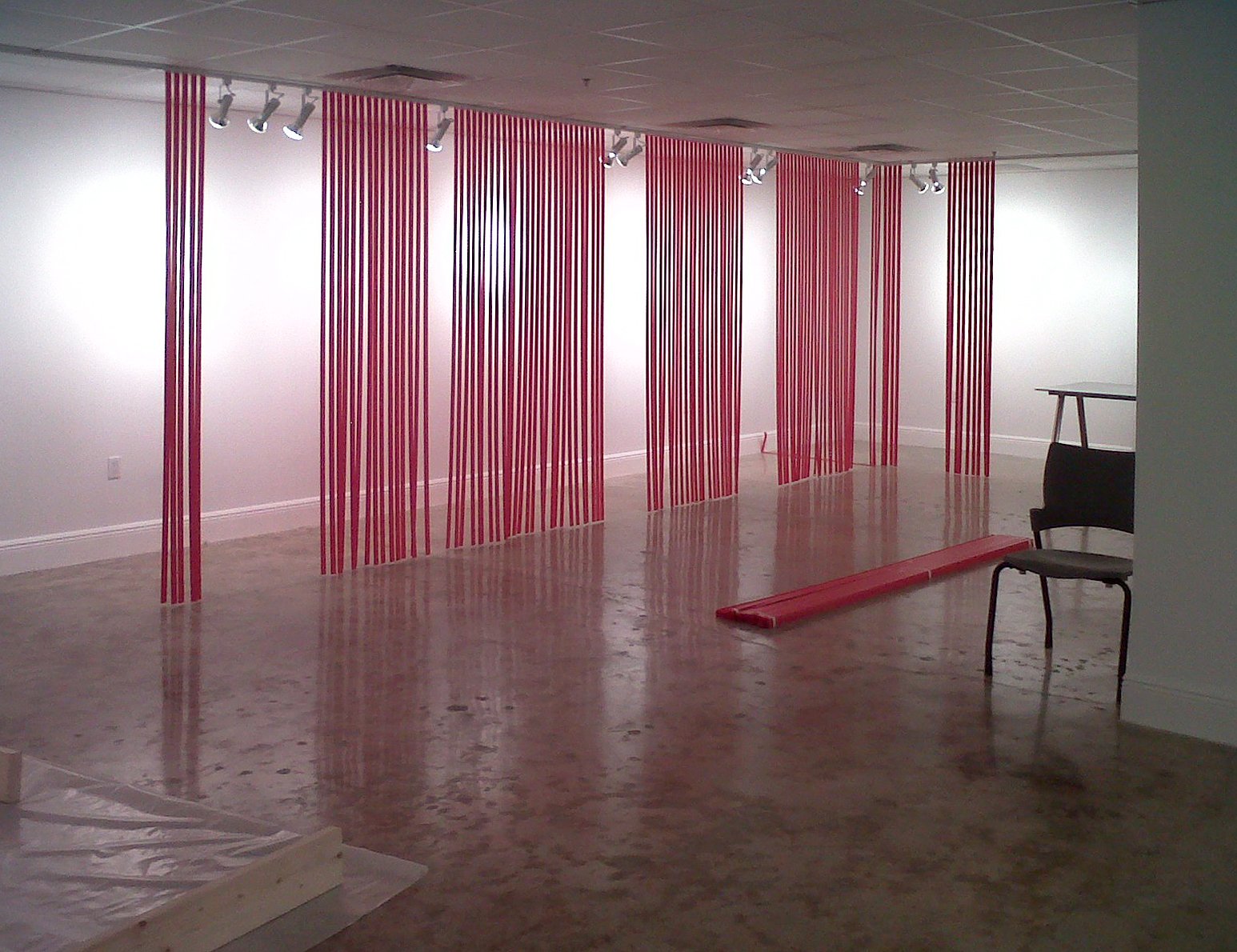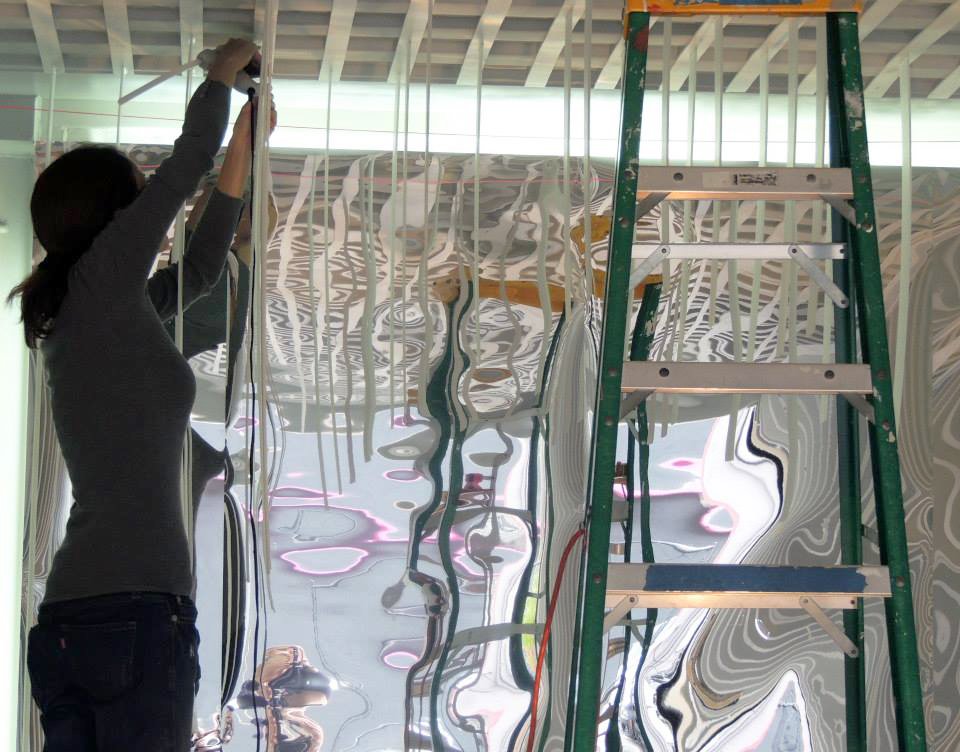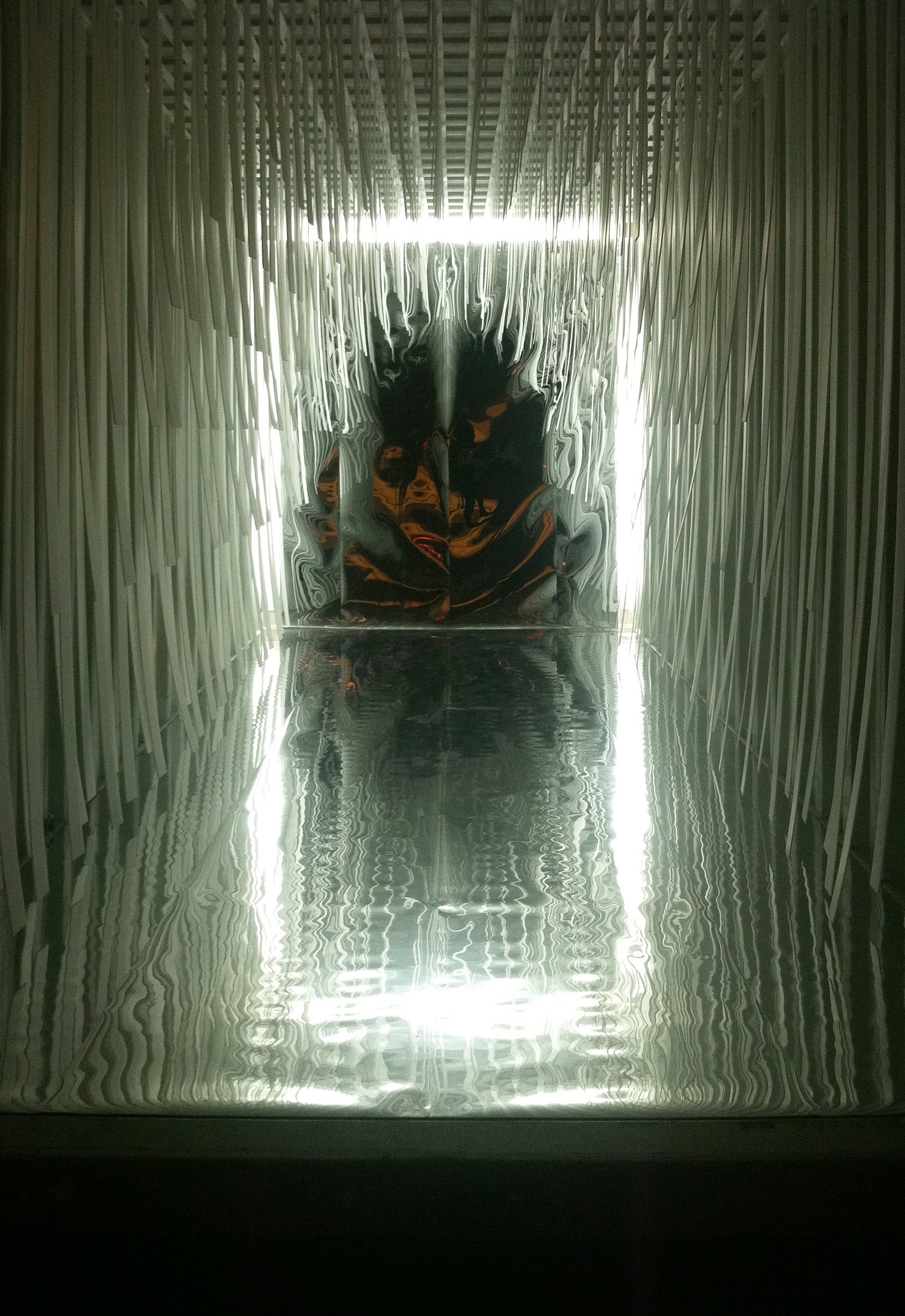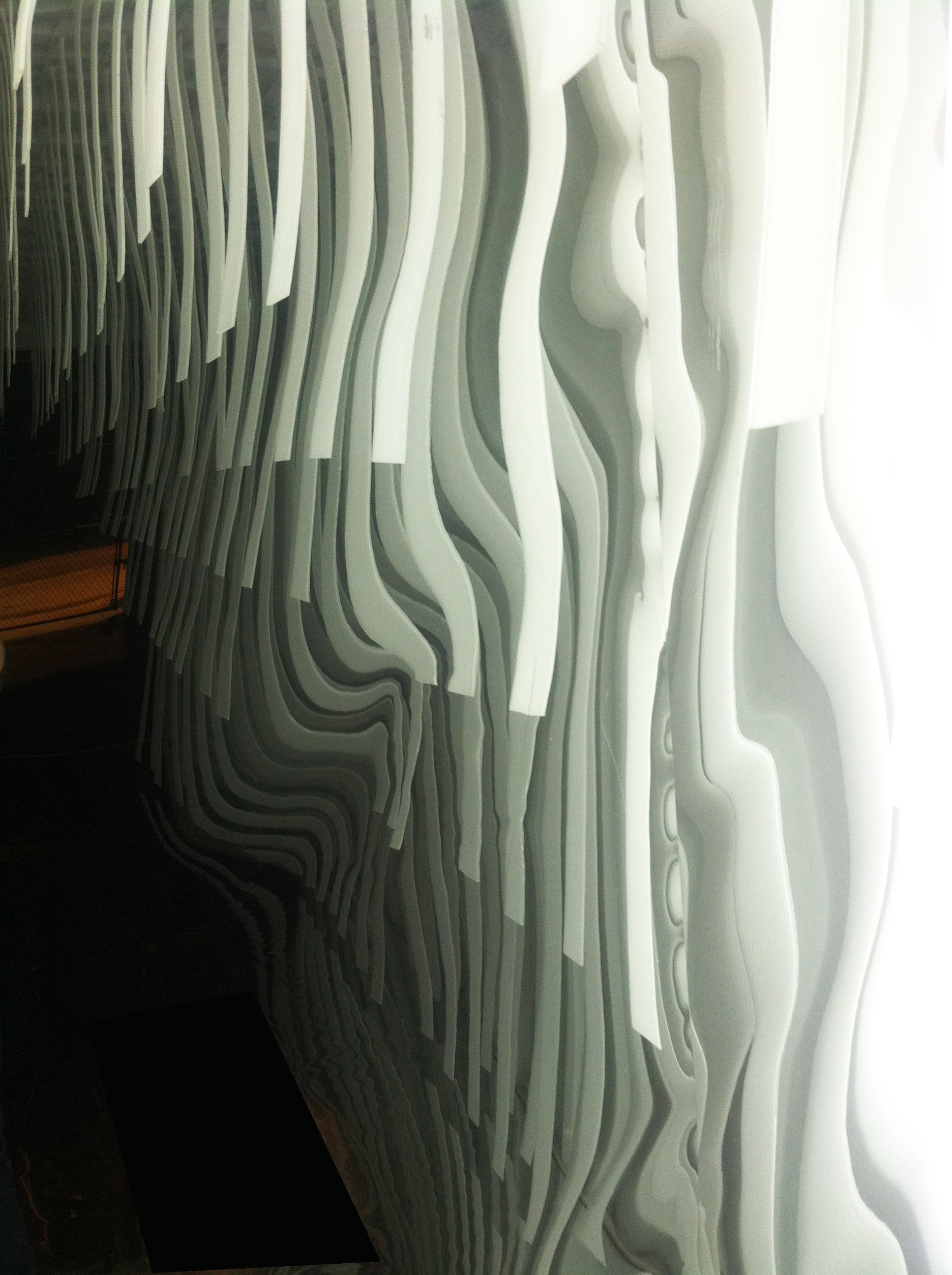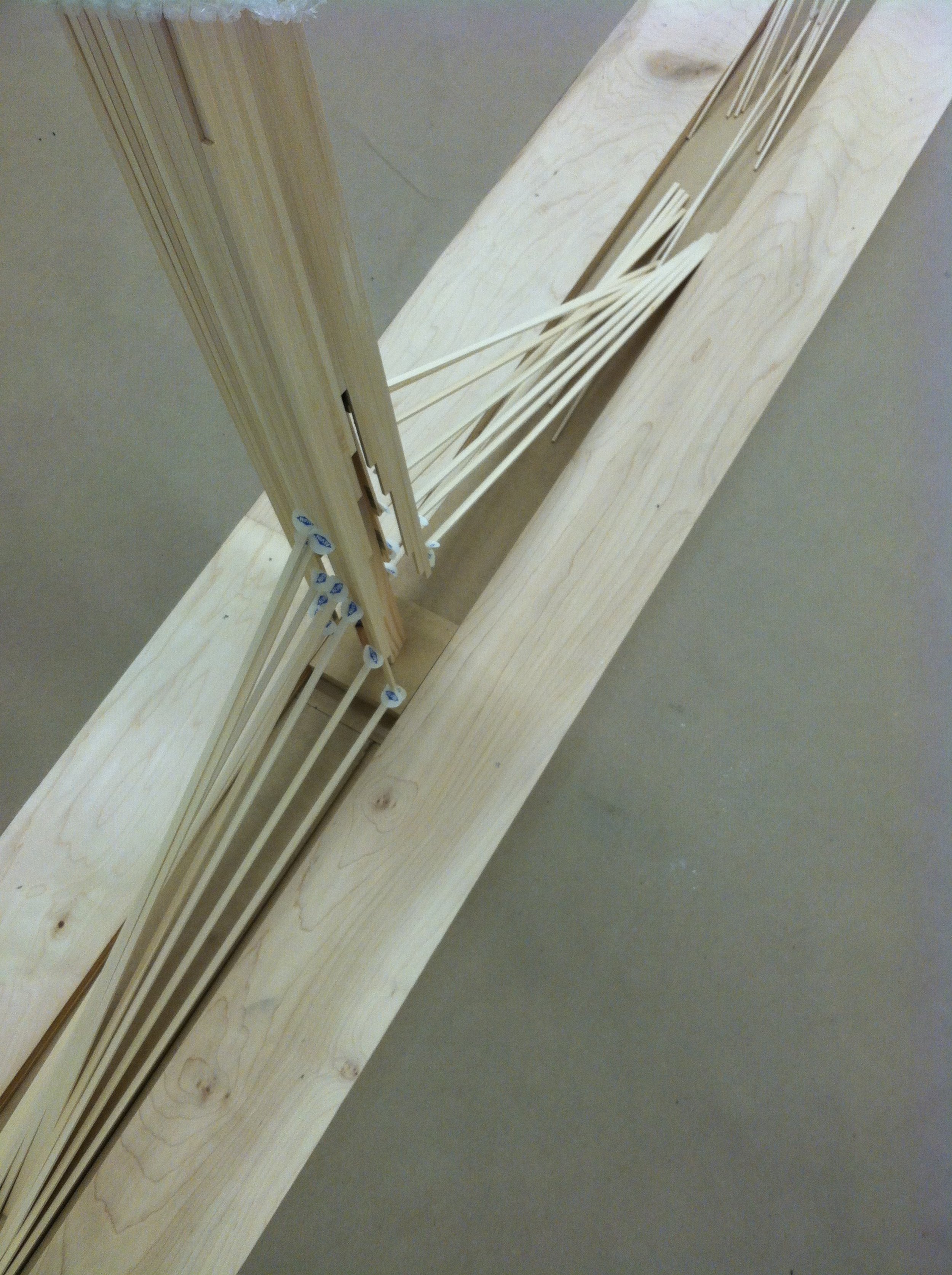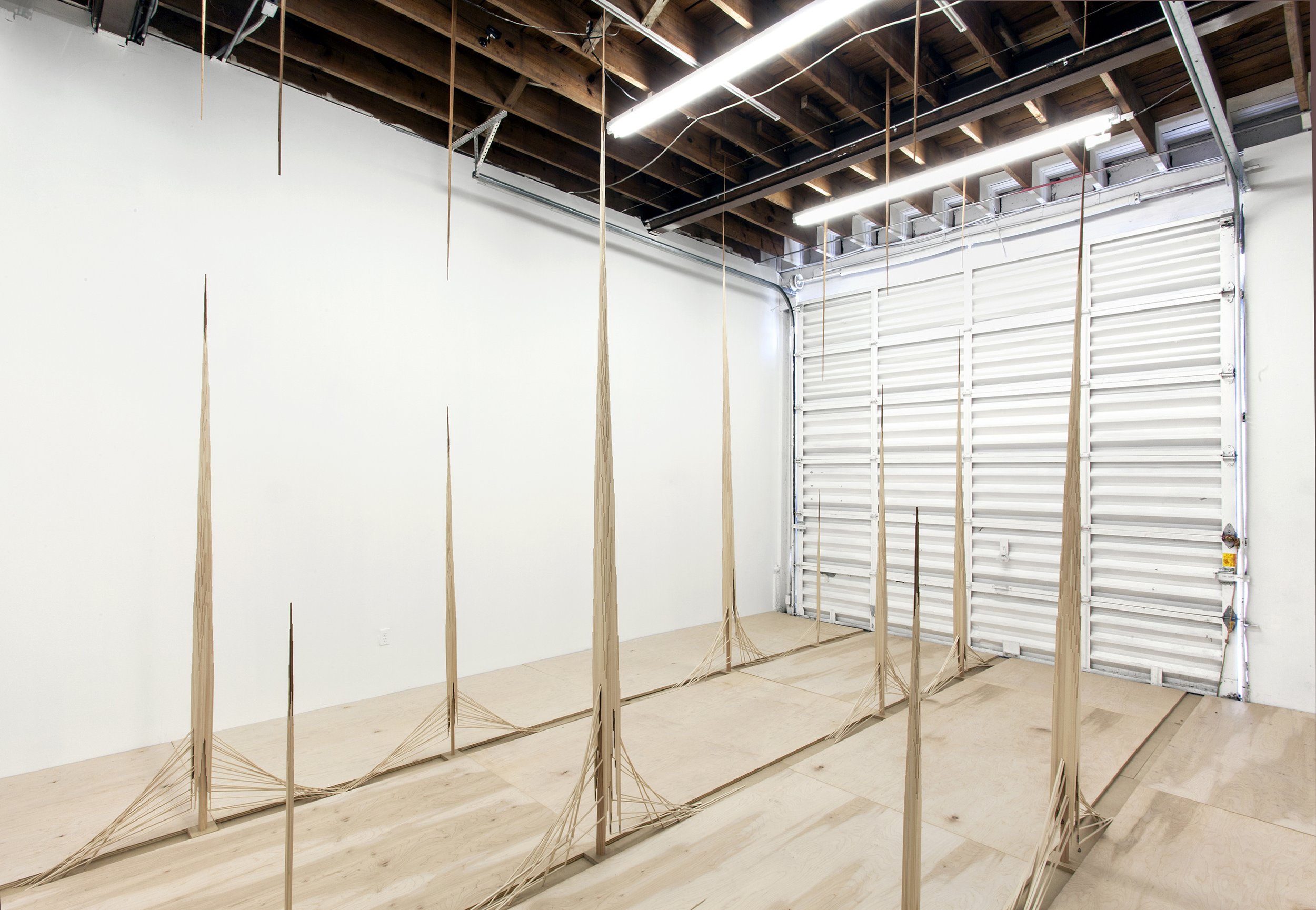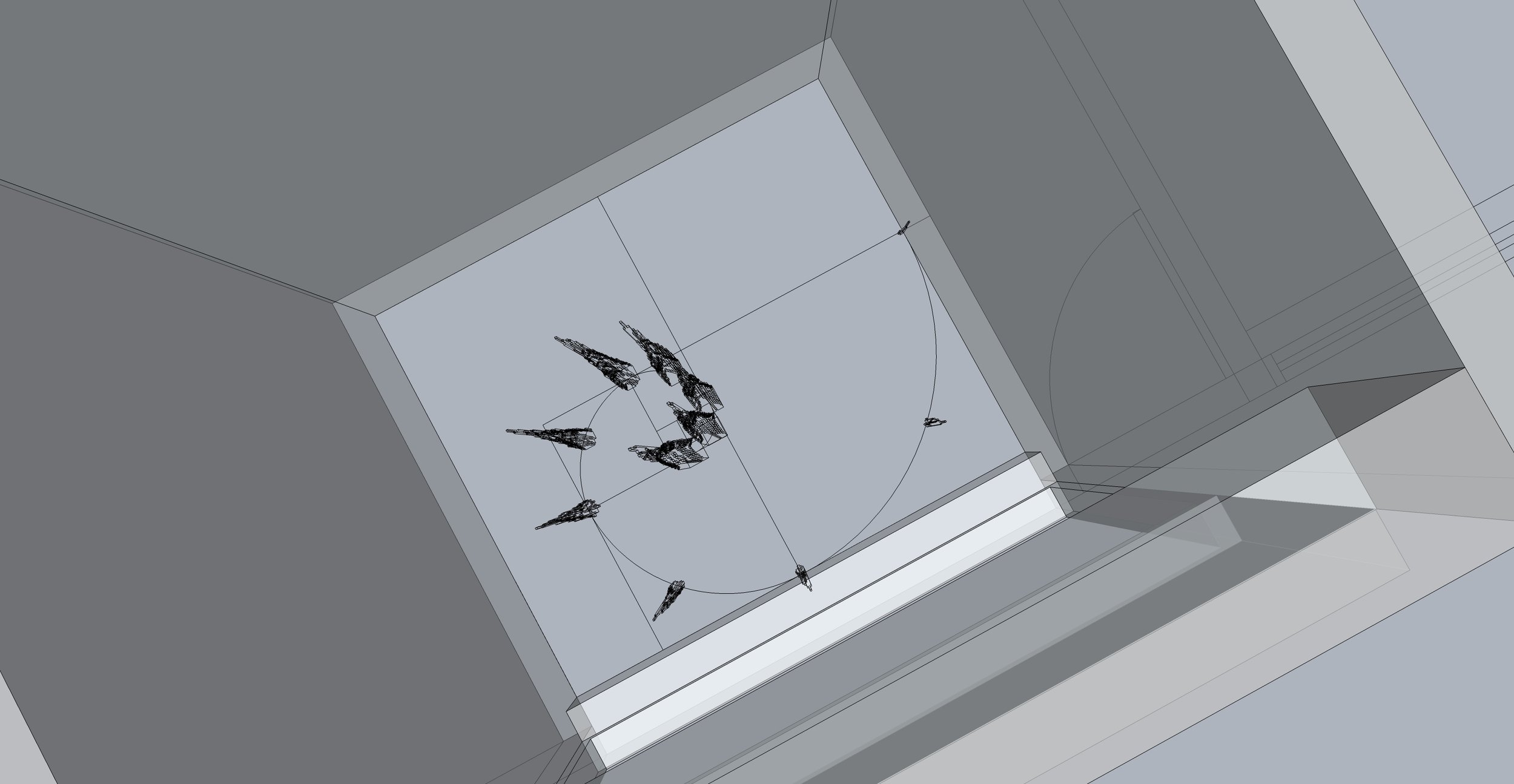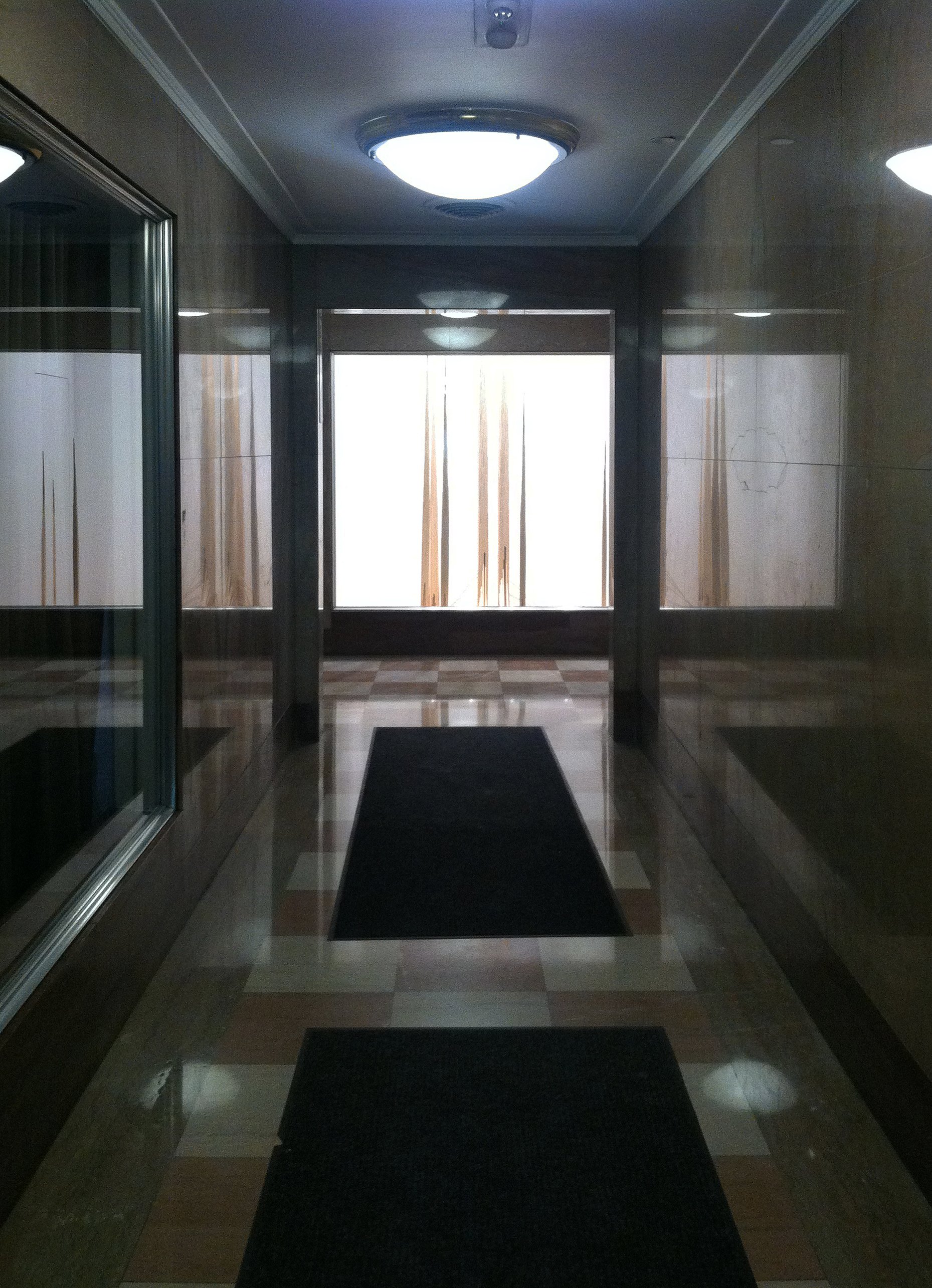installation
There is nothing wrong with your television set. Do not attempt to adjust the picture. We are controlling transmission. If we wish to make it louder, we will bring up the volume. If we wish to make it softer, we will tune it to a whisper. We will control the horizontal. We will control the vertical. We can roll the image, make it flutter. We can change the focus to a soft blur or sharpen it to crystal clarity. For the next hour, sit quietly and we will control all that you see and hear. We repeat: there is nothing wrong with your television set. You are about to participate in a great adventure. You are about to experience the awe and mystery which reaches from the inner mind to…The Outer Limits. — Opening narration, The Control Voice, 1960s
THE OUTER LIMITS: Exploring the overlaps between space, place and artifact—a perforation is introduced. A moment, a window, and a possibility that may transmit a disruption in the fabric of Dimensions Variable by introducing a variable dimension.
THE OUTER LIMITS, image of scale model (2011)
detail of THE OUTER LIMITS
detail of THE OUTER LIMITS
THE OUTER LIMITS, image of scale model (2011)
THE OUTER LIMITS, image of scale model (2011)
THE OUTER LIMITS, fabric wrapped panels & video with audio (2011), Dimensions Variable, Miami
detail of THE OUTER LIMITS
THE OUTER LIMITS, (collaboration with Samantha Salzinger), fabric wrapped panels & video with audio (2011), Dimensions Variable, Miami
THE OUTER LIMITS, (collaboration with Samantha Salzinger), fabric wrapped panels & video with audio (2011), Dimensions Variable, Miami
detail of THE OUTER LIMITS
detail of THE OUTER LIMITS
detail of THE OUTER LIMITS
THE OUTER LIMITS, image of scale model (2011)
exterior view of THE OUTER LIMITS
exterior view of THE OUTER LIMITS
PRELUDE: “Meaning is wrought from the undecidable text only when a portion of the field of reference has been provisionally and contingently isolated or “framed,” that is, when most of the interminable directions of reference are repressed so that one privileged direction of referral emerges, as if from a signifier to a signified. Yet the other threads of reference cannot simply be erased to yield the desired meaning. Framing produces meaning only in and as the violent repression of other strands of meaning which nevertheless continue to occupy the text, a condition that deconstruction, borrowing from Freud, refers to as the return of the repressed.” Jeffrey Kipnis, “Nolo Contendere,” Assemblage 11 April 1990: 54-57, digital rendering, (2012)
PRECIS: A trace operates simultaneously by both pronouncing an existing condition and reframing that condition against other conditions. Depending on how this is strategized, the trace is both active and passive as our minds eye reads and rereads the trace (figure) against its background (field). digital rendering, (2012)
STRATEGY: At the MBUS gallery the existing gallery walls are lit by standard track lights that may be focused on standard framed and wall hung objects of art. I attempt to reframe this traditional presentation of art by creating a reverse negative condition. I will map the space between the track lights and feature the negative space of light on the blank wall itself. The ambition of this exploration lies in the consideration of how one potentially may pause to consider a work of art itself.
MATERIAL: Red corrugated plastic cut into strips under the existing track lights within a wall of the gallery.
TRACE (for group exhibition IMPERMANENCE), red Coraplast & glue (2012), Miami Beach Urban Studios (MBUS), Miami Beach
TRACE (for group exhibition IMPERMANENCE), red corrugated plastic & glue (2012), Miami Beach Urban Studios (MBUS), Miami Beach
TRACE (for group exhibition IMPERMANENCE), red corrugated plastic & glue (2012), Miami Beach Urban Studios (MBUS), Miami Beach
detail of TRACE
detail of TRACE
FEELING PLASTIC: “Before any local corpus (the biological body, formal economics, military state, legal corporation, geographic nation, scientific accounting, sculptural debris, or immanent theology) can conserve and appreciate its self-image within the boundaries of its preferred reflection, already its Vitruvian conceits of diagrammatic idealization, historical agency, radiating concentric waves of embodiment, instrumental prostheticization, and manifest cognition are, each in sequence, unwoven by the radically asymmetrical indifferences of plastic matter across unthinkable scales, both temporal and spatial. But while the received brief for political aesthetics is denuded, abnormal assignments proliferate.” Benjamin Bratton, ‘Some Trace Effects of the Post-Anthropocene: On Accelerationist Geopolitical Aesthetics’, e-flux, journal #4657, still of digital model, (2015)
FEELING PLASTIC: Plastic is a material that we consume, mold, ship and disperse. It is also the core of our material economic relations – they are made from oil. In addition, we are ‘plastic.’ We are consumed, molded, shipped and dispersed in the 21st century form of social production. With virtual bodies, affecting our actual bodies, and vice versa, what is it to both materially and immaterially ‘feel plastic?’, still of digital model, (2015)
FEELING PLASTIC (for group exhibition 4409.72 miles 9125 days 25 years of art discourse from Buenos Aires to Miami), 8’ x 8’-6” x 20’ corrugated steel shipping container & 3” x 1/8” x various cut lengths of translucent corrugated plastic corrugated glued to support frame & minimum 1/4” mirrored paper on floor and illuminated rear wall (2015), Diana Lowenstein Gallery, Miami FL
interior of FEELING PLASTIC
interior of FEELING PLASTIC
interior of FEELING PLASTIC
fabrication of FEELING PLASTIC
fabrication of FEELING PLASTIC
fabrication of FEELING PLASTIC
FEELING PLASTIC (for group exhibition 4409.72 miles 9125 days 25 years of art discourse from Buenos Aires to Miami), 8’ x 8’-6” x 20’ corrugated steel shipping container & 3” x 1/8” x various cut lengths of translucent corrugated plastic corrugated glued to support frame & minimum 1/4” mirrored paper on floor and illuminated rear wall (2015), Diana Lowenstein Gallery, Miami
interior of FEELING PLASTIC
detail of FEELING PLASTIC
FEELING PLASTIC (for group exhibition 4409.72 miles 9125 days 25 years of art discourse from Buenos Aires to Miami), 8’ x 8’-6” x 20’ corrugated steel shipping container & 3” x 1/8” x various cut lengths of translucent corrugated plastic corrugated glued to support frame & minimum 1/4” mirrored paper on floor and illuminated rear wall (2015), Diana Lowenstein Gallery, Miami
interior of FEELING PLASTIC
detail of FEELING PLASTIC
FEELING PLASTIC, digital model (2015)
interior of FEELING PLASTIC
detail of FEELING PLASTIC
detail of FEELING PLASTIC
A FABRICATED FIELD: "The clumped formations rise like beanstalks or cypress knees through the space, creating a visual contrast between the machined plane and the organic bundles that belies an inter-territorial tension. This tension serves to bind, or speculatively fold in the outside, considering edges beyond the anthropocentric. Grodin concludes, 'If we think of the necessity of survival through migration, a movement, an interface, or a trajectory speaks of the evolution of all species in the face of extinction. This requires a sideways glance to create such abstract spaces. Rather than grasping at individual straws my work attempts to assemble fields of straws as speculative landscapes'.”
A FABRICATED FIELD: "Trained as an architect, Grodin situates her artistic practice within the realm of geophilosophy—a field of thought that considers the formations between territories. For her installation, Grodin will fabricate a raised sub-floor encompassing the entirety of the project room. Gaps between the standard 4’x8’ grid of plywood sheets allow for another system to emerge. Bundles of wooden sticks rise at irregular intervals, both subverting the grid and binding it together like mycelium to create an all-encompassing installation", still of digital model (2014), Project Room, Locust Projects, Miami
A FABRICATED FIELD, still of digital model (2014), Project Room, Locust Projects, Miami
A FABRICATED FIELD, subfloor plan (2014), Project Room, Locust Projects, Miami
A FABRICATED FIELD, floor plan (2014), Project Room, Locust Projects, Miami
A FABRICATED FIELD, ceiling plan (2014), Project Room, Locust Projects, Miami
A FABRICATED FIELD, hundreds of bass wood sticks were glued together by hand over the span of one year to create (11) floor sculptures & (11) ceiling sculptures, (2014)
A FABRICATED FIELD, close-up view of 'stalks', (2014)
A FABRICATED FIELD, view of 'stalks' before installation, (2014)
A FABRICATED FIELD, view of plywood before installation, (2014)
A FABRICATED FIELD, view of all components before installation, (2014)
detail of A FABRICATED FIELD during installation
view of A FABRICATED FIELD during installation
view of A FABRICATED FIELD
view of A FABRICATED FIELD
detail of A FABRICATED FIELD
detail of A FABRICATED FIELD
detail of A FABRICATED FIELD
view of A FABRICATED FIELD during installation
view of A FABRICATED FIELD, photo by Zack Balber, image courtesy of Locust Projects
view of A FABRICATED FIELD, photo by Zack Balber, image courtesy of Locust Projects
view of A FABRICATED FIELD, photo by Zack Balber, image courtesy of Locust Projects
view of A FABRICATED FIELD
view of A FABRICATED FIELD
detail of A FABRICATED FIELD
view of A FABRICATED FIELD
SPIKE: According to Wikipedia "The golden ratio has also been used to analyze the proportions of natural objects as well as man-made systems such as financial markets, in some cases based on dubious fits to data." Therefore there is a connection, a spiraling trajectory, between the idea of market spikes and real estate specifically within the context of Miami. Also according to Wikipedia the Alfred I. DuPont Building "is an example of Moderne architecture and was the first skyscraper built after the County courthouse and the bust of 1928. Thus it represents Miami's emergence from the great depression."
detail of SPIKE during installation
detail of SPIKE during installation
SPIKE: The original ground 'stalks' used in A FABRICATED FIELD, Project Room, Locust Projects, Miami FL, are re-deployed in a diorama setting within the historic Alfred I. DuPont Building in downtown Miami, still of digital model, (2014). This project was commissioned by Tiliarts' Diorama Project
SPIKE, still of digital model (2014)
SPIKE, still of digital model (2014)
view of SPIKE
view of SPIKE
view of SPIKE
SPIKE, still of digital model (2014)
SPIKE, still of digital model (2014)
view of SPIKE
SPIKE, still of digital model (2014)
view of SPIKE
view of SPIKE
SPIKE, still of digital model (2014)
view of SPIKE
view of SPIKE (interior)
view of SPIKE (interior)
detail of SPIKE
detail of SPIKE
IN THE STICKS: (collaboration with Linda Chamorro) will utilize one of Grodin’s previous works, A FABRICATED FIELD (grounds 'stalks'), originally installed at Locust Projects in Miami in 2014, and re-contextualize it outside the domain of the art gallery and into a rural setting. The fabricated field of bundled wooden sticks will be installed in an undisclosed location in the Redland agricultural district – a highly managed landscape on what was formerly a mosaic of freshwater wetland and rockland forest. In doing so, it aims to interrogate the perceived separate spheres of cultural spaces (which produce with ideas), agricultural spaces (which produce with land), and ecological spaces (which produce with wind, fire, water, and seed). By returning the sticks ‘to the sticks’ they will in time break down and return carbon to soil. We de-fabricate the field, engaging in a ritual of re-integration. This project was part of the A.I.M. Biennial, (2020)
detail of IN THE STICKS during installation
detail of IN THE STICKS during installation
view of IN THE STICKS
view of IN THE STICKS
view of IN THE STICKS
view of IN THE STICKS
view of IN THE STICKS
view of IN THE STICKS
view of IN THE STICKS, (2021) - one year later
view of IN THE STICKS, (2021) - one year later
detail of IN THE STICKS, (2021) - one year later
detail of IN THE STICKS, (2021) - one year later
detail of IN THE STICKS, (2021) - one year later






















